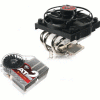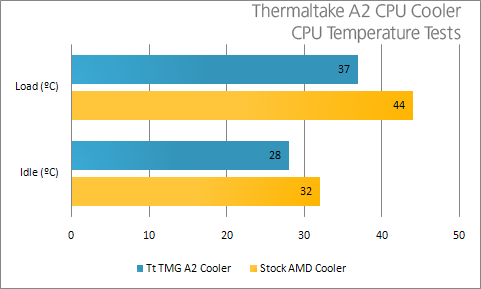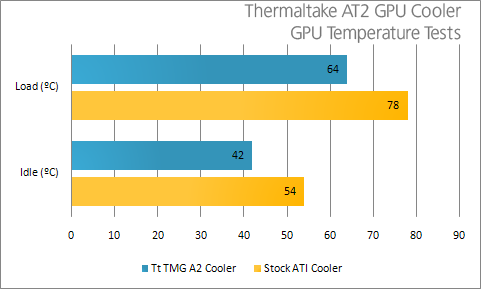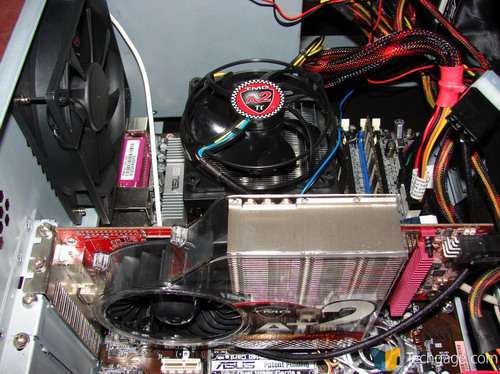- Qualcomm Launches Snapdragon 4 Gen 2 Mobile Platform
- AMD Launches Ryzen PRO 7000 Series Mobile & Desktop Platform
- Intel Launches Sleek Single-Slot Arc Pro A60 Workstation Graphics Card
- NVIDIA Announces Latest Ada Lovelace Additions: GeForce RTX 4060 Ti & RTX 4060
- Maxon Redshift With AMD Radeon GPU Rendering Support Now Available
Thermaltake TMG A2, AT2 Coolers

Thermaltakes slogan for their TMG cooler lineup is “Quality Life Starts With Silence.” We have been pleased with the cooling performance of their products in the past, but silence and good cooling ability are two difficult things to put together. Let’s take a look at how well both the A2 CPU cooler and AT2 GPU cooler perform in our tests.
Page 5 – Thermal Performance and Noise
For this review, I’m using my friend Zach’s machine again, which you may remember from my earlier review of the Antec SOLO case. It’s not the most blisteringly high-end machine, though it does have significant potential for heat generation with its AMD dual-core processor operating at 2.2GHz, and a hot ATI X1800XT graphics processor.
- CPU: AMD Athlon 64 X2 4400+ CPU
- Motherboard: ASUS A8N-SLI Deluxe
- Memory: 2 x 512MB PC2700
- Video: ATI Radeon X1800XT 512MB Video Card
- Sound: Onboard HD Audio
- Storage: Two 7200RPM Hard Drives: 1 WD, 1 Seagate
- Case: Antec SOLO
- Etcetera: Windows XP Professional w/ SP2, Antec SmartPower 2.0 Power Supply, DVD-RW Drive
(Products linked are to our reviews)
ATITool was used to stress the CPU, Northbridge, and GPU, and the same test with default settings was run for each configuration tested. For each temperature measurement, the motherboard’s onboard data acquisition system and internal thermistors were used. Through all testing, Cool n’ Quiet features of the motherboard were enabled, as they will likely be in actual use. ASUS Q-fan was disabled, so that the CPU cooler would always run at the fan’s full speed. Under load, temperatures were allowed to stabilize for 10 minutes during each test. The three-speed case fan was set to HIGH speed during thermal testing.
Overall, the TMG coolers delivered solid cooling performance, keeping the CPU and GPU significantly cooler than their respective stock coolers. The cooler upgrade was more beneficial to the GPU, with its temperature dropping 14 degrees when compared to the stock ATI cooler; the CPU dropped 7 degrees as well when compared to the stock AMD cooler. It’s safe to say that these coolers provide a worthwhile drop in temperatures when compared to the stock coolers.
Fairly impressive as well was the drop in system noise after installing the TMG coolers. The most significant noise reduction was with the change from the stock ATI cooler to the Thermaltake TMG AT2. The AT2’s blower generated a soft whoosh of airflow, and a barely-detectable whine produced by the blower wheel itself. Any noise contributed to the AT2’s noise signature by its blower motor, however, was inaudible. Personally, I’d prefer to use the AT2 with a variable-speed or automatic fan controller, or splice its leads into the old connector on the video card itself, in order to use its onboard thermal control function for complete silence when idling.
The A2 cooler on the processor sounded much like any case fan while running at full speed, though with ASUS Q-Fan enabled, and the fan spinning at about 1500 RPM, it was virtually inaudible as well. I’m a stickler for noise, and I’m known among my enthusiast friends to have an almost obsessive aversion to computer noise. However, I could certainly live with the noise level produced by the A2 cooler, when used with the motherboard’s automatic fan control function.
One concerning thing I noticed upon firing up the A2 cooler for the first time was a very high-pitched metal-on-metal whine. This went away after about five minutes of operation, however. I’m not sure what this means, or whether you should be concerned by this. If the whine doesn’t go away, it’s an almost sure sign of absence of lubrication in the motor. Also, Thermaltake claims that the A2’s fan is spring-mounted, much like the similar Arctic Cooling products (whose fans mount on compliant rubber studs), but Thermaltake’s spring-loading method doesn’t provide any true isolation, since the fans are still retained by plastic studs. It would have cost Thermaltake less to simply attach the fan with the plastic studs alone.


|
|
Support our efforts! With ad revenue at an all-time low for written websites, we're relying more than ever on reader support to help us continue putting so much effort into this type of content. You can support us by becoming a Patron, or by using our Amazon shopping affiliate links listed through our articles. Thanks for your support!






